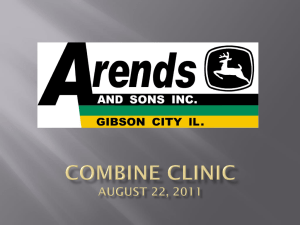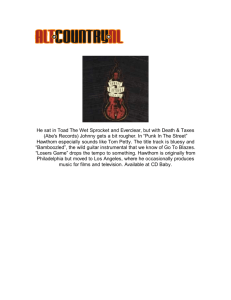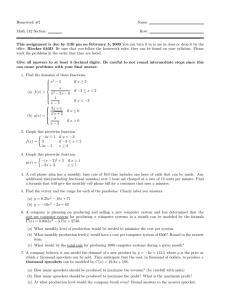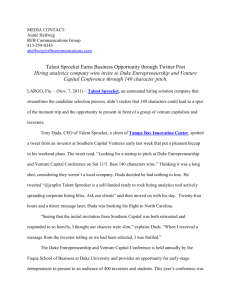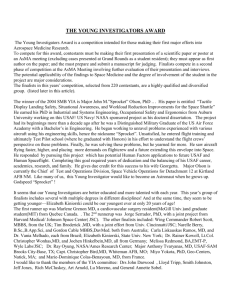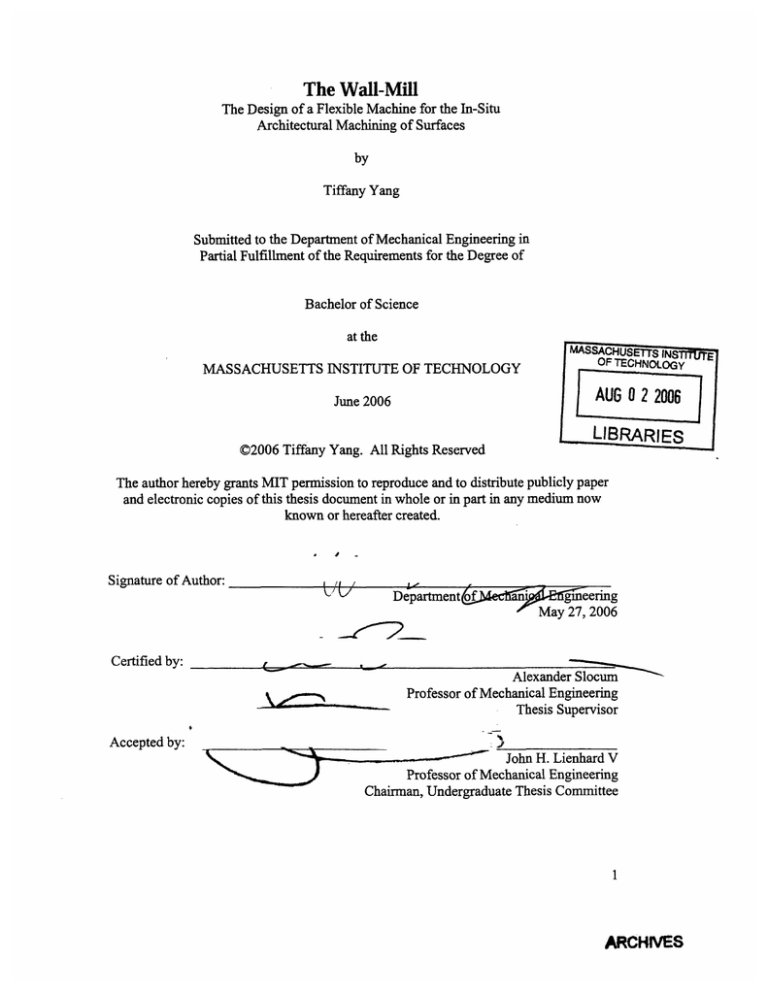
The Wall-Mill
The Design of a Flexible Machine for the In-Situ
Architectural Machining of Surfaces
by
Tiffany Yang
Submitted to the Department of Mechanical Engineering in
Partial Fulfillment of the Requirements for the Degree of
Bachelor of Science
at the
MASSACHUSEiTS
INSTT
MASSACHUSETTS INSTITUTE OF TECHNOLOGY
OF TECHNOLOGy
June 2006
AUG 0 2 2006
LIBRARIES
C2006 Tiffany Yang. All Rights Reserved
The author hereby grants MIT permission to reproduce and to distribute publicly paper
and electronic copies of this thesis document in whole or in part in any medium now
known or hereafter created.
L.//
·
Signature of Author:
-
DepartmentoMee
geering
May 27, 2006
-
Certified by:
^
'11~-
Alexander Slocum
Professor of Mechanical Engineering
Thesis Supervisor
I
Accepted by:
:)
XZZZ
............
, :John H. Lienhard V
Professor of Mechanical Engineering
Chairman, Undergraduate Thesis Committee
1
ARCHIVES
The Wall-Mill
The Design of a Flexible Machine for the In-Situ
Architectural Machining of Surfaces
by
Tiffany Yang
Submitted to the Department of Mechanical Engineering
On May 12, 2006, in partial fulfillment of the
Requirements for the degree of
Bachelor of Science
Abstract
Water-like wave patterns on surfaces are seen in the walls of the Glaphyros Apartment in
Paris, France and in the Frankfurt Nightclub in Frankfurt, Germany (designed by Mark
Goulthorpe). These 3-D surfaces were created by first constructing molds which is an
extremely time-consuming and inefficient process. It is also difficult to transport a large
mold from the machine shop where it was created to the building site where the panel
will be installed. Additionally, the non-modularity of molds requires that a new one be
created for a different design. It would be much simpler and efficient if the mold is
replaced with a portable apparatus that can machine the surface directly. The main
concept is a vertical milling machine appropriately named the Wall-Mill. The goal of
this thesis project is to design and construct a prototype of the Wall-Mill.
Thesis Advisor: Alexander Slocum
Title: Professor of Mechanical Engineering
2
Acknowledgments
This project would not have gone from design to implementation without the generous
help of Mark Belanger, Edgerton Shop Manager and Instructor. The Wall-Mill would
still be in pieces if it were not for his expertise.
I would also like to thank Derrick Tan, Gregory Scholl and Ben Zelnick. Derrick played
an integral part in designing the carriage of the Wall-Mill. His V-shaped design was
implemented. Greg machined all the test cars to test the mathematical theories, some of
which he helped analyze. Both Derrick and Greg's input in the initial stages of the
design was invaluable as well as Ben's input in the last stages of the design especially the
y-actuation of the Wall-Mill.
Many thanks to Steve, Joe and the two Bobs from Pappalardo for kicking me out of the
lab for 2.007 but more importantly, helping with the construction of the Wall-Mill
whenever they can.
I would also like to thank Tsubaki for their kind donation of curved roller chains to this
project. The Wall-Mill was designed around it.
Last but definitely not least I would like to thank Professor Slocum for his infinite
patience, advice and supervision with this thesis. I know I gave him many grey hairs (or
lack of).
3
Contents
1 Introduction ......
........................................
5
2 Design Requirements and Selection ..............................
6
2.1
FRRDPARC ...............................................
7
2.2
Feasibility Analysis ........................................
8
2.3
2.4
Design Refinement .........................................
Solidworks and Design Explanations ...................
12
15
3 Implementation ........................................
3.1 Parts Selection ...............................................
.......
19
19
4 Comments ............................................................
21
5 Further Work ..............................................
22
4
1
Introduction
Even in protruding curved walls of Simmons Hall (designed by Steven Hal) and the Ray
and Maria Stata Center (designed by Frank Gehry) in Cambridge, MA, the interior walls
are still smooth and flat as in Figure 1.
Contrary to this typical approach there has
been a recent interest in walls with 3-D
forms including the Glaphyros Apartment in
Paris, France (Figure 2) and in a Frankfurt
Nightclub in Frankfurt, Germany both
designed by architect Mark Goulthorpe.
The three-dimensional protrusions in these
abstract walls resemble water flow and wave
patterns providing a soothing effect that
"washes away the stress of life."
patterned
panel was
Figure 1: Smooth and flat walls of Simmons Hall,
Each wave-like
MIT
created by constructing a mold in a 3-axis
CNC machine first and then using an appropriate manufacturing method with the mold to
produce the final 3-D panel as seen in these buildings.
As with many molds, it is very time consuming to create one and the larger the mold is in
size the more time it takes. Another problem with the mold's fairly large size is the
dltticulty in transport trom the machine shop where
it was created to the building site where the panel
will be installed. An innate problem with any mold
is that it is not modular. Each mold is unique and
the only way to produce a different pattern for the
wall panel is to go through the entire tedious
process of creating a new mold.
In response to this problem this paper present a
design for the Wall-Mill, a portable apparatus that
would machine flat or curved surfaces (walls,
panels) directly. The surfaces would be constructed
of soft materials including drywall and wood.
Besides aesthetic walls and panels, these surfaces
can be adapted for better acoustics such as
auditorium walls or highway sound barriers.
Additionally., the cost of the apparatus must be
cheaper than the current method. This thesis
examines the design of such an apparatus and the
construction of an alpha prototype. The next
Figure 2: Wave-like panel in Glaphyros
Apartment in Paris, France
section provides a general overview of the design as well as the analysis that led to the
final design. The actual implementation of the design, i.e. the construction and assembly
5
is described in section 3. Section 4 comments on the overall Wall-Mill and section 5
conclude with future work.
2
Design Requirements and Selection
Four main considerations for the Wall-Mill when deciding on a strategy and design:
·
·
Ability to machine curved and flat surfaces
3-axis machining capability
·
Portability
·
Cost-effectiveness
The selected strategy was a vertical milling machine appropriately named the Wall-Mill.
The basic idea is to have a long linear guide for the y-axis (up and down) travel with a
linear actuator mounted on it for the z-axis travel (in and out). A spindle is mounted on
the linear actuator to hold the tool for machining (see Figure 3). The linear guide would
be supported by a guide rail nailed to the floor and a guide rail nailed to the ceiling.
While the design requirements allowed the y- and z- axis motions of the Wall-Mill to
follow conventional actuation, the x- motion (travel along the surface) had to be designed
for this particular application. An FRRDPARC chart (Table 1) was constructed to
analyze different possible designs for the x-axis motion as well as the overall frame.
I
wAL a
I
I
I
I
"J
I
/
/
a
Figure 3: Rough sketch of preliminary design
6
~ ~
cvl
o
0~
s'I
~~
cto~
c~
~~~~c So
~ ~
~ Eo
~
0~-~~~
0
0
C-
.-
U,
o &Z a.
~~0
E
C)
o
.E.
00 c/~~~~~
cC)~~~~~~~
0
CO~~~~~~~~~r
0
C
001
C
E
.~~~~~~
tn
0~~
©.
~~0
-~
~~~~~~~~~~
0
~0~.
3'
~
Q)
0
L" C) ~~~~~~~~~~~~~~1C
-o
c,
C)
2CL
-,o
C)
-a
0
Q
-
E
0
Ncu
U,
~~~~~~~~
r:
C.),g~~~~~~~~~C
0
-o-=.~
0
~
-
=
U
u
00
IC)e
cu
U
U
~oo0 ~_~~~o
-0
0
~' -
~0
o
~~
E> o
n~
n~
n~
9t
A4i
..
0
.
0
0
0
::S
.
o
EE
.
H0
2.2
FRRDPARC Analysis*
The two functional requirements (both were potential design parameters for the frame)
that needed further analysis were the (1) radius of the pipe bending in elastic region and
(2) the noise generated from sprockets traveling on roller chains.
(1) Mathematical Analysis of Feasibility of Pipe Bending Design
For this analysis, the goal was to calculate if the minimum radius of curvature of a pipe or
I-beam is small enough to be used as a guide for the Wall-Mill. The radius of curvature
will highly depend on moment of inertia of each cross-section.
MathematicalTheory
I
D2
Figure 4: The cross-section of a pipe.
In Figure 4, if:
d_i = the inner diameter of a hollow pipe
d_o = the outer diameter of a hollow pipe
then the moment of inertia of a pipe is:
I=
I
r2 dA
= [ (d04
(1)
-
di4 ]/64
(2)
it
d
I
Figure
5:W
Figure 5: The cross-section of an I-beam.
8
In Figure 5, the moment of inertia of an I-beam is:
I = (2tw 3+dt 3)/6w
Y
F1
1
T
M
1
1
V¢
x
Figure 6: Beam bending. The radius of curvatureis illustrated.
In Figure 6, if:
p = the radius of curvature (from the center of curvature to the neutral axis)
dO = the incremental change in angle
then from simple geometry:
p*dO = ds
(3)
1/p = dO / ds
(4)
And assuming that this will be a small deflection so that ds approximate equals dx:
1/p = dO / dx
(5)
An excel model was generated from the equations above using pipes and I-beams of
different diameters, thickness and materials. From the table, none of the modeled shapes
is small enough to be used as an x-axis actuator. For example, a copper tubing of 0.3"
thickness with an outer diameter of 1.2" has a radius of curvature greater 75". Hence it
appears that it is not feasible to elastically bend and secure a pipe to act as a guide rail. A
countermeasure is needed, ad can be found in the se of special roller chain
(2) Vertical Motion and Sprocket Analysis
This analysis was to determine if the sprocket and roller chain can be used for actuation
in the design of the Wall-Mill. In particular, is the noise i.e. vertical motion from the
sprocket traveling over the rollers of the chain less than 0.1 mm. It was important to
know that the Wall-Mill would be able to machine a wall as smooth and precise as
possible in order to be comparable to the mold method. The maximum vertical motion as
a function of sprocket dimensions was modeled in Excel. This was to test which sprocket
size and the number of teeth to see if any is acceptable for the application.
9
MathematicalTheory
As a sprocket is pushed along a roller chain, the path will look like a series of semicircles. But the maximum disturbance will be when the sprocket is traveling over one of
the rollers i.e. the top of a semi-circle.
travel path sprocket
willtake as it goes
PIT;
Figure 7: Illustration of a sprocket engaged in a roller chain. The geometry used for determining the
maximum vertical motion is drawn out.
Using simple geometry, as seen in Figure 7 above, if:
n = number of teeth on a sprocket
r = sprocket radius
0 = angle between teeth
P = sprocket pitch
then:
0 = n/n
P = 2*r (sin 0)
Maximum vertical motion = r (1-cos 0)
(6)
(7)
(8)
Equation (7) determines r, which is then plugged into equation (8) to solve for the
maximum vertical motion. The graph below (Figure 8) was generated from the equations
and used to visualize how the vertical motion varied with different sprocket sizes and
teeth number. The orange line demarcated the 0.1mm tolerance and everything below
that line was acceptable for the Wall-Mill.
10
Vertical Motion vs. Number of Teeth
-- Pit
-itch
3
1
112'
Pitch 58'!
0.3000
-·: ·Pitcn
-,*--Pih
3/4'
1'
0.2500
E
c 0.2000
0
7 0.1500-
0.1000
0.0500
0.0000
60
70
80
90
100
110
120
130
140
150
160
170
180
190
200
210
220
Numberof Teeth
Figure 8: Disturbance as a function of number of teeth on a sprocket and pitch size. The smaller the
pitch and the more number of teeth, the less the noise is.
Bench-Level Testing
To verify the theory behind the spreadsheet a simple car was constructed (Figure 9) to
test the accuracy of the spreadsheet.
Figure 9: test car to verify mathematical prediction of the
vertical motion of a sprocket as it travels on a roller chain.
A dial indicator was placed on top of the test car to measure the changes in vertical
motion as it traveled along the roller chain (ANSI 40). Table 2 is the results of 10 runs
of the test car. The excel model predicts the vertical motion for an ANSI 40 chain with
20 teeth to be less than 0.5mm. Since the average vertical disturbance of the test runs is
0.53mm, the excel model is fairly close. Thus, the use of the sprocket and chain was
used in the design.
11
Run Number
Vertical Motion (mm)
1
0.49
2
3
4
0.53
0.49
0.47
5
0.55
6
7
0.56
0.54
8
0.54
9
10
0.49
0.51
Average:
0.52
Table 2: Results from different trials of the test car. The average vertical noise
of the test runs is close to the mathematically predicted value and thus verifying it.
2.2
Design Refinement
Since the analysis concluded that the roller chain and sprocket is a better option than
bending a pipe, both the top and bottom of the Wall-Mill was designed to be guided by
sprockets. The general design of the Wall-Mill remained the same with a linear guide in
the center attached to two sprockets on the bottom and two sprockets on the top. But the
roller chain and sprocket concept was refined to further minimize the vertical motion.
Section 2.2.1 describes and analyzes the improved design and section 2.2.2 analyzes a
potential problem with the improved design.
2.2.1
Half-Pitch Offset Design
The central idea to the improved design is for two sprockets to be spaced (n + 0.5) pitches
apart so that there will be half a pitch offset. The half-pitch offset provides minimal
movement in the center because one sprocket will be traveling over a roller and the other
sprocket will be in the valley between two rollers (Figure 10). This way the middle of
the carriage where the machine tool will be located has as little disturbance as possible.
12
Figure 10: Test car to examine feasibility of refinement of sprocket and chain
concept. The sprockets are half a pitch out of phase so that there is minimal
movement in the center.
MathematicalTheory
As seen earlier, a sprocket travels along a series of semi-circular path as it rolls over the
chain. Thus the path it takes can be modeled as the circumference of a semi-circle.
the travel path of a sprocket
as it rolls over a chain
Lr-
Figure I1: The semi-circular path of a sprocket traveling along a roller chain. The geometry of the
path for analysis is shown.
In Figure 11, if:
r = the radius of the circle
L = half the chord length of the circle
0 = the angle between the two drawn radii
m = the circumference of the circle between the two points
and by properties of a right triangle:
sin 0 = L/r
(9)
0 = sin'l(L/r)
(10)
then the semi-circular travel path of a sprocket traveling over a roller chain is:
13
m = rO
(11)
(12)
m = r*sin ' l(L/r)
This equation was used to model the sprocket and chain offset concept in Excel to predict
the movement of the center distance between the two sprockets. In the resulting graph
(Figure 12), the first sprocket will follow the purple path and the second sprocket will
follow the blue path. Thus the center distance between the two sprockets will have a
vertical motion following the light blue path.
Horizontal Motion vs. Vertical Motion
0.000
0.020
0.040
0.060
0.080
0.100
0.120
0.140
0.160
0.180
0.200
0.000
-0.002
-0.004
-0.006
-0.008
-0.010
-0.012
-0.014
-0.016
Horizontal Motion (inches)
Figure 12: The vertical motion of the sprockets as the test car travels along the roller chain. The
center of the test car which is the addition of sprocket one and sprocket two shows that the vertical
motion in the center is at a minimal when the sprockets are
Bench-Level Testing
Since the mathematical model predicted a maximum vertical motion of less than
0.005mm for the center point between the two sprockets, another simple test car was built
to test the theory. A dial indicator was placed in the center to measure the vertical motion
as the car traveled along the roller chain. The tested values were similar to the predicted
values and thus the design was implemented for the Wall-Mill.
2.2.2
Half-Pitch Offset Concern
When the sprockets make a curve their offsets are no longer half-pitch apart. With each
14
curve, the offset will either increase or decrease. A concern is that eventually the offset
increase or decrease will add up enough so the sprockets will be in phase. The analysis
of this concern was to ask if the difference between the arc length and the chord length
equals half the pitch of the sprocket (see Figure 5). In mathematical terms (based on the
previous analysis of the design):
2m - 2L = /2 Pitch
(13)
* If the difference between the lengths of the arc and chord (2m-2L) equals half the
pitch, then the half-pitch offset will completely be eliminated and the sprockets
will be in-phase.
* If the difference is greater or smaller to half the pitch then the sprockets will still
be out-of-phase but not half-pitch out-of-phase.
* If the difference is zero than the sprockets are traveling on a linear path and will
retain the half-pitch offset.
There are many considerations that will determine how much the offset will change
including the distance between the sprockets and the radius of curvature. The smaller
the radius of curvature, the greater the offset will be eliminated. The worst case scenario
is if the offset was completely eliminated and the two sprockets are in-phase. Since the
minimum radius of curvature is a property of the roller chain, an Excel sheet was created
to analyze the worst case scenario.
Table 3: Analyzes the variation in distances between the two sprockets initially set at half-pitch offset
as they o around a curve.
distance
ANSI Pitch min.
n radius
of curvature
Ac sprockets
[inches]
35
40
50
60
80
0.375
0.500
0.625
0.750
1.000
19
19
19
19
19
cord
length
[inches]
[inches]
[inches]
7.3125
9.7500
12.1875
14.6250
19.5000
10
14
16
20
24
7.4861
9.9586
12.5032
14.9722
20.0806
curve
offset
> 1/2
pitch?
1/2
pitch
0.1736
0.2086
0.3157
0.3472
0.5806
No
No
Yes
No
Yes
0.1875
0.2500
0.3125
0.3750
0.5000
* n = number ofpitches a part between the sprockets. Distance betweensprockets= (n*0.5)*P, where P
is thepitch.
For an ANSI 50 chain, the minimum radius of curvature is 16" (see Table 3). So if two
ANSI 50 sprockets were placed 12.1875 inches (with a half-pitch out-of-phase) apart and
traveling on a 16" curved roller chain, the two sprockets would become in-phase after
they travel around the curve which is the worst case scenario. However the first sprocket
and chain analysis showed that the vertical noise would be acceptable. Thus the worst
case scenario is if the improved half-pitch offset design is eliminated and the sprockets
perform like the first bench-level experiment.
2.3
Solidworks and Design Explanations
15
In the following sections, the design of the Wall-Mill is shown using Solidworks and
explained. The first section is the overall design and the following sections details how
the design requirements, as stated earlier, are fulfilled.
2.3.1
Overall Design and Description
Sprocket carriage
Nes
Nes
guide
Figure 13: Solidmodel of overall Wall-Mill
16
N
m-;"~pnng
I.
Figure 14: Top of Wall-Mill. Sprocket
carriage attached to nested tube by a pin.
r
ff
Figure 15: Tensioning system of exposed.
The internal spring pushes the Wall-Mill
against the ceiling and floor.
*
The overall frame of the Wall-Mill is a perforated nested tube (an inner tube that
telescopes out from an outer tube) sandwiched between two sprocket carriages.
*
An internal spring (see Figure 14) tensions the nested tubes against the ceiling and
floor to stabilize the Wall-Mill. The spring also dampens any bumps acting like a
suspension.
A linear guide is mounted on the nested tube. On the carriage of the linear guide
sits a linear actuator. The linear actuator holds a router which machines the wall.
* The nested tubes are attached to the sprocket carriages by a pin so that the tubes
can rotate according to the pitch-offset design. Both sprocket carriages are
identical.
·
Inside the sprocket carriages are constant force springs to align the sprockets
when they rotate from traveling along the curved roller chains.
* The path of the Wall-Mill will be determined by the roller chains attached to the
ceiling and floor.
2.3.2
Ability to machine curved and flat surfaces (Modularity)
Since it is the surfaces to be machined that are variable, the Wall-Mill design allows the
17
surfaces to determine the path the Wall-Mill will take. Unlike conventional roller chains
(Figure 16),
'"""'
..
kfigure Ib: Tchecurvature ot a conventional roller chain.
Figure 17: Tsubaki's special curved roller chain.
Tsubaki's special roller chain (Figure 17) has the ability to flex in an additional direction
which allows it to align along a curving wall. When the roller chains are aligned
according to the surface, they are then nailed to the floor/ceiling. This becomes the track
that the Wall-Mill will take. Thus, the Wall-Mill can machine a curved or flat surface as
it follows the path laid out by the roller chains.
2.3.3
3-Axis Machining Capability
X-Axis
The x-axis is the direction along the travel path of the Wall-Mill as determined by the
roller chains and the surface. This motion is controlled by two driven sprockets, one in
the top sprocket carriage and one in the bottom.
Z-Axis
The z-axis is the direction into and out of the surface and determines the depth of cut of
the Wall-Mill. This motion is controlled by a linear actuator which is mounted on the
linear guide.
18
Y-Axis
The y-axis is the direction along the nested tube and linear guide. It is the up and down
motion of the Wall-Mill. This is controlled by a sprocket driven by the motor behind the
linear actuator. The sprocket rides on a vertical roller chain attached off of the nested
tube.
2.3.4
Portability (Assembly)
There are only seven loose pieces when the Wall-Mill is dissembled:
1.
2.
3.
4.
5.
6.
7.
3
top sprocket carriage
bottom sprocket carriage
linear guide mounted on nested tube
linear actuator with spindle
top roller chain
bottom roller chain
vertical roller chain
Implementation
[pictures of final assembly will be inserted here]
3.1
Parts Selection
3.1.1
Spindle Selection and Calculations
The spindle is RYOBI's 1-1/2 hp router (Model R162-1K) bought off the self. Since the
router is meant to cut wood, the power and speed is definitely sufficient for the WallMill. The stall torque and an approximate cutting force can be calculated from RYOBI's
specifications.
Specifications of Router:
to = no load speed = 25000 rpm
P = power =1.5 hp
At maximum power, the operating torque is at half the stall torque (T = /2 Ts) and the
operating speed is at half the no-load speed (o = V2 con). In other words,
T= P*63025/co
(14)
T = (1.5*63025)/12500
T = 7.56 in-lbs.
and thus the stall torque (s) is 15.12in-lbs.
The cutting force depends on the tool diameter which is unknown at this time but for
19
approximation purposes the collet size (/4¼"diameter) will suffice.
F=T/r
·
·
3.1.2
(15)
Approximate operating force = 60.48 lbs
Approximate maximum force (stall motor) = 121 lbs.
Motor Selection
The Wall-Mill is using three Ford windshield wiper motors which were used for MIT's
Design and Manufacturing I class. Though not as compact as other motors, it has the
necessary torque and speed ratio to drive the Wall-Mill.
Requirements for Wall-Mill to operate:
F = translational force (60.48 lbs)
r = radius of sprocket (2.16")
xT= Fr
(16)
= (60.48 lbs)*(2.16")
= 131 in-lb total
Since there are two motors driving the Wall-Mill, each motor needs to be able to provide
a torque of 65 in-lbs. Each motor is able to provide the necessary torque as Table 2
shows.
Ford Motor Company Windshield Wiper Motor
No Load Low Speed @ 13.8 volts
50 rpm
Stall Torque
14 N-m
123.9 in-lbf
Table 4: Ford Motor Company windshield wiper motor specifications
Connected clockwise (black and white).
3.1.3
Sprocket and Roller Chain Selection
The sprocket size selection was limited by the sizes Tsubaki had available since Tsubaki
is the only known manufacturer of these special curved chains. Tsubaki only
manufactured these chains in ANSI sizes 35, 40, 50, 60 and 80 (see Table 5). However,
the maximum allowable load for ANSI 35 is 210lbs. which is not robust enough for this
application. The predicted weight of the Wall-Mill was approximately 2001bs. And from
the previous analysis, the noise is minimal with more teeth and smaller the pitch. Thus,
RS50CU was chosen.
20
Table 5: Specifications of Tsubaki's curved roller chain.
us
:. :
Average-: .' Maximum:
TSUeaK
'a
3.1.4
*
*
*
4
a
N.-
Tensile
Allowable
- .pproL
'A
Weliti
A
:TinV
RS35CUA
1,800
210
.22
RS40CU
3,480
420
.41
RS5OCU
5,420
640
.68
RS60CU
7,830
900
.94
RS80CU
13,840
1,560
1.66
Other parts used
TNK Linear Guide
TNK Linear Actuator
US Digital Corporation Encoder
Comments
The Wall-Mill design explicitly addresses each of the requirements in this paper so far
except for one, cost-effectiveness which will be addressed in this section. The Wall-Mill
cost approximately $1565 to build the alpha prototype excluding shipping charges which
is definitely cost saving compared to the mold method. However there were many items
(see Table 6) that were lying around i.e. free and used in the design. The cost of labor is
also not tallied in the worksheet. If all the parts (linear actuator, bearings, electronics,
etc) were counted towards the cost as well as machine time, then a rough estimate of the
total cost is approximately $5000. Compared to the mold method, the Wall-Mill would
still be more cost-effective.
Company
McMasters
McMasters
McMasters
McMasters
McMasters
Item
McMasters
Flanged Ball Bearings
Spider Couplings (Hytrel Spider)
Spider Couplings (Al. Coupling hub)
Nested Tube (2" sq., 8ft. long)
Nested Tube (1.75" sq, 4ft long)
Sprockets (ANSI 50, 20 teeth, 5/8" bore)
Central
Machine
Home Depot
McMasters
McMasters
McMasters
McMasters
Stock pile
Stock Material (Aluminum, Steel)
Spindle (Ryobi Router)
Roller Chain
Compression Spring
Idler sprocket
Constant Force Spring
Linear Guide
Unit Price
Quantity
4.06
4
4.57
2
4
1
23.37
44.08
21.62
22.11
200.00
59.97
4.97/ft
14.80/pack
18.87
5.08
720
1
4
1
1
10
1
2
2
1
Total Cost
16.24
9.14
93.48
44.08
21.62
88.44
200.00
59.97
49.70
14.80
37.74
10.16
720
21
Stock pile
Stock pile
Donated
Guide Blocks
Linear Actuator
Motors
Tsubaki Roller Chain
Electronics
Sensors
150
1
150
total
1565.04
Table 6: Bill of materials for the Wall-Mill.
5
Further Work
Since this is only an initial study on the design of the machine, there is a lot that can be
done to carry the Wall-Mill further. The controls needs to be added to the Wall-Mill so
that it can actually machine the wall and have all three-axis capability. The motors and
digital encoders are already built into the frame work for the controls.
The alpha prototype addresses all four of the design requirements ability to machine
curved and flat surfaces, 3-axis machining capability, portability and cost-effectiveness
However, there are many improvements that can be made to each of these requirements.
* The sprocket and roller chain design of the y-axis motion can be improved with a
linear actuator. This way the Wall-Mill has more precision and is more selfcontained.
* The router needs to be replaced with a cordless spindle to allow for a longer xaxis travel.
* The entire machine needs to be driven from a battery or an AC power (long cord).
* Replace the router with an actual spindle to increase the z-axis reach.
* A more efficient method or tool needs to be created to align the roller chain along
the surface and nail it to the ground.
22


